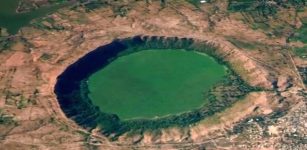Ring Of Fire: Gigantic Zone Of Frequent Earthquakes And Volcanic Eruptions
MessageToEagle.com – The Ring of Fire refers to a very geologically active section of the world, the Pacific Rim.
In fact, it’s not really a full circle, but rather a horseshoe-shaped zone of frequent earthquakes and volcanic eruptions.

The Ring of Fire, which is a 25,000 mile (40,000 km) is not just a coincidence but the geological setting of the Pacific Rim which leads to it being so active.
This gigantic region on our planet has its ‘firing ‘name because within it, there are 452 active and dormant volcanoes.
It means that the Ring of Fire includes 75% of the world’s active volcanoes and is also responsible for 90% of the world’s earthquakes.
The Ring of Fire stretches from the southern tip of South America, up along the coast of North America, across the Bering Strait, down through Japan, and into New Zealand, and multiple Pacific Islands such as Papua New Guinea.

The Ring of Fire is the result of plate tectonics, huge slabs of the Earth’s crust, which fit together like pieces of a puzzle. The plates are not fixed but are constantly moving atop a layer of solid and molten rock called the mantle.
See also: Amasia – New Future Supercontinent
Sometimes these plates collide, move apart, or slide next to each other. Most tectonic activity in the Ring of Fire occurs in these geologically active zones.
Among 452 volcanoes of the Ring of Fire, there are some very famous and dangerous.
For example:
Popocatepetl – an active volcano in the Trans Mexican Volcanic Belt. Located near Mexico City, this volcano is considered by many to be the most dangerous in the world since a large eruption could potentially kill millions of people.
Mt. Saint Helens -The Cascade Mountains in the United States’ Pacific Northwest hosts the 800 mile (1,300 km) Cascade Volcanic Arc. The Cascades contain 13 major volcanoes and nearly 3,000 other volcanic features. The most recent eruption in the Cascades occurred at Mt. Saint Helens in 1980.
The Andean Volcanic Belt within the Andes Mountains (longest, continental mountain range in the world) is broken into into four volcanic zones that include such active volcanoes as Cotopaxi and Cerro Azul. It is also home to the highest, active volcano — Ojos del Salado.
Mt. Fuji, located on the Japanese island of Honshu, Mt. Fuji, at 12,380 feet (3,776 m), is the tallest mountain in Japan and the world’s most visited mountain and an active volcano that last erupted in 1707.
Krakatoa – In the Indonesia Island Arc sits Krakatoa, remembered for its massive eruption on August, 27, 1883 that killed 36,000 people and was heard 2,800 miles away (it is considered the loudest sound in modern history).
The Indonesian Island Arc is also home to Mt. Tambora, whose eruption on April 10, 1815 was the largest in major history, being calculated as a 7 on the Volcanic Explosion Index (VEI).
Learn more:
Ring Of Fire: Home To Powerful And Deadly Forces Lurking Deep Beneath Earth’s Surface
MessageToEagle.com
Expand for referencesReferences:
Related Posts
-
 Where Do Diamonds Come From?
No Comments | Jun 3, 2016
Where Do Diamonds Come From?
No Comments | Jun 3, 2016 -
 Golden ‘Etruscan’ Orphic Book – Six Golden Pages Of The Oldest Book In History Of Mankind
No Comments | Mar 27, 2020
Golden ‘Etruscan’ Orphic Book – Six Golden Pages Of The Oldest Book In History Of Mankind
No Comments | Mar 27, 2020 -
 Strange Magnetic Forces Around Lonar Lake – What’s Behind The Electromagnetic Anomaly?
No Comments | Dec 7, 2017
Strange Magnetic Forces Around Lonar Lake – What’s Behind The Electromagnetic Anomaly?
No Comments | Dec 7, 2017 -
 Boobrie: Shape-Shifting Mythical Horror Bird From Scottish Highlands
No Comments | Feb 9, 2017
Boobrie: Shape-Shifting Mythical Horror Bird From Scottish Highlands
No Comments | Feb 9, 2017 -
 Svantevit – Four-Headed War God Of The Slavic Peoples Of Central Europe
No Comments | Sep 14, 2015
Svantevit – Four-Headed War God Of The Slavic Peoples Of Central Europe
No Comments | Sep 14, 2015 -
 Mariana Trench: Deepest Part Of The World’s Oceans
No Comments | Feb 12, 2016
Mariana Trench: Deepest Part Of The World’s Oceans
No Comments | Feb 12, 2016 -
 8 Clues That Suggest Parallel Universes Do Exist
No Comments | Nov 5, 2017
8 Clues That Suggest Parallel Universes Do Exist
No Comments | Nov 5, 2017 -
 Winds On Uranus And Neptune Can Reach Supersonic Speeds
No Comments | Feb 1, 2016
Winds On Uranus And Neptune Can Reach Supersonic Speeds
No Comments | Feb 1, 2016 -
 Childhood Home Of Jesus May Have Been Found Underneath The Sisters Of Nazareth Convent
No Comments | Nov 24, 2020
Childhood Home Of Jesus May Have Been Found Underneath The Sisters Of Nazareth Convent
No Comments | Nov 24, 2020 -
 Extraordinary Photographic Memory Of Genius Stephen Wiltshire
No Comments | Jan 28, 2016
Extraordinary Photographic Memory Of Genius Stephen Wiltshire
No Comments | Jan 28, 2016
